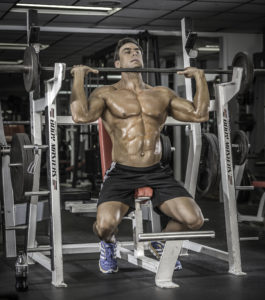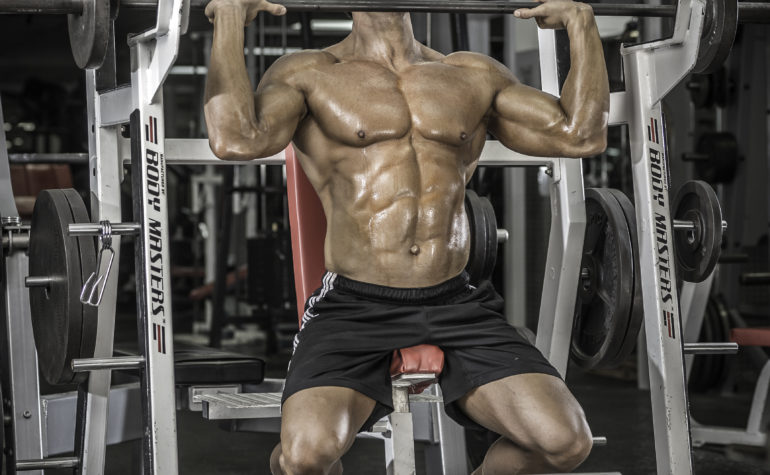 Shoulders really top off a physique as they give the illusion of with and power, but how to build massive shoulders?
Shoulders really top off a physique as they give the illusion of with and power, but how to build massive shoulders?
Let me tell you what the answer is NOT: lifting heavy stuff blindly overhead and grunting loudly. This will only get you hurt. If I ran my NYC personal training business this way, I would be homeless.!
I laid out a multi layered approach for your shoulders to grow! If you are in a rush, here is the done for you workout!
Understand the function of the shoulder
Looking that the shoulder, there are two levels of muscles involved: the deltoids (most visible) and underneath them, the rotator cuff.
We will focus on the three different groups of muscles that form the deltoids:
The anterior head aka front delt is the piece located in the front of your shoulder. It starts on the front of the clavicle, runs down and across, and attaches to your humerus. One of the roles of the anterior delt is creating shoulder flexion, meaning raising your arm in front of your body.
Picture doing a front raise or any type of press or pull for that matter. This muscle gets by far the most work from all the deltoids leading to over development and increased injury risk. ( this is why nobody should be doing from raises, ever)
The middle head or side delt lies next to the anterior head and is more central. It begins at the top of your scapula and attaches to the outer portion of the humerus. Your middle or lateral delts also contribute to shoulder flexion, but they also help create shoulder abduction. Shoulder abduction occurs when you bring your arms away laterally from the mid line of your body as in a side raise or a v pull.
The posterior head starts on the back of the scapula and also attaches on the humerus. Your posterior delts or the forgotten delts are responsible for shoulder extension. Shoulder extension occurs when you bring your humerus back behind your body as in rear delt flyes or bend over rows with the elbows pointing to the side.
If you peeled away the deltoids, underneath them, you would find a deep layer of four muscles called the rotator cuff. The main function of these muscles is to stabilize your shoulder joint. These are best trained with either the shoulder horn or the cable via inward and outward rotation.
Check yourself before you wreck yourself!
The great thing about the shoulder? It is the only joint tin the body that can do 360 degrees. The problem: it can do 360 degrees so it is suspect to injuries.
The shoulder takes a beating during any type of weightlifting program and most injuries occur from over development and tightness of the anterior part or front of the delts. This then leads to inflammation of the bicipital tendon and can create rotator cuff issues as well.
Additionally, due to activities such as extended work in from of a computer, the shoulders are often chronically elevated, thereby causing strain on the neck, which in turn can trigger referred pains such as migraines, elbow, and wrist pain.
Here are four simple tests you can do to make sure your shoulders are functioning well:
THE ROTaTOR CUFF TEST
Sit one a bench, with one foot elevated. Then grab a small dumbbell, prop the elbow against the knee and rotate the weight upward for 10 – 12 reps. If you cannot use 8 – 10% of your incline bench weight, you are on the fast track towards a blown shoulder. Example: if you can bench 200 lbs, you need to be able to do 20 lbs.
Here is how to fix it!
- 3×10 inward rotations
- 3×10 outward rotations at cable or with rubber band.
- 3×10 reverse shrugs – this exercise is set up as follows: sit at the lat pull down machine, with a medium-wide overhand grip. Pull the shoulder blades down for about 2-3 inches, without bending the elbows. The goal is to work the lower part of the traps, without involving latissimus or biceps too much.
THE WaLL SLIDE TEST
Stand leaning against a wall, while raising the hands above the head. If the shoulders come off or cannot stay close to the wall, your shoulder flexibility is impaired and an injury is on its way.
To stay healthy:
Do wall slides three times a day, ideally get your coworkers involved as they are probably tight as well.
THE PUSH PULL TEST
If your bent over row or seated does not match your incline bench in pounds and reps, you are off balance, so you will need to add 10-20 pull ups every workout (or any type of pull down/ row to create balance)
THE Towel TEST
Grab a towel or a rubber band that is wider than shoulder width and hold it straight out. Rotate it behind the body and then back forward.
If you cannot do a full rotation, go as low as possible without forcing anything. Do 3×20 reps every day. Strive to increase range of motion on a weekly basis. You must think of this just like brushing your teeth, simply do it every day and do not take days off.
Additionally, a good (licensed and with good references) acupuncturist can keep your shoulders happy and healthy. Even though we don’t understand how acupuncture works, the benefits are undeniable and the downside is small.
The actual workout
. Always start with rear delt flyes. Why? the rear delt is chronically under worked, overstretched from the computer and generally weak. This will hurt you in several ways
1. In terms of aesthetics since it takes away from the complete back development
2. It makes you more prone to injury since you will develop a forward hunched physique with pressure on the rotator cuff, the biceptal tendon and your scalene ( muscles that
B. Do not do front raises. The front delt is over developed as is and does not need extra work as it gets trained every time you push or pull something
C. Lean forward when doing side raises. When it comes to training shoulders, remember the following : Whatever is on top, works. So when standing totally upright, you are actually training your front delts whereas a slight lean forward will work the medial head.
D. Press inward. Yes, you should do presses but do them smartly. Simply hoisting weights up and down will not magically develop great, round shoulders. Pressing straight up is merely a triceps exercise, instead try having an inward intention at all times ( the exception being the ahrens press where you press away)
E. Learn the clean and press. The clean and press is a great way to either warm up the delts for work to
F. Do rotator cuff exercises as outlined this will increase your strength and
G Cover the strength curve, this
!
Conclusion
Training the shoulder requires a strategic approach. You need to understand the functions of the delts, keep them healthy and train them individually for powerful delts!

Thanks for the tips!
Thanks for reading, good luck with the delts!